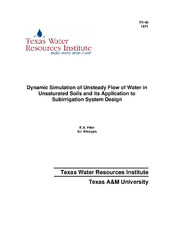| dc.description.abstract | Two computer programs were developed. One simulated vertical unsteady infiltration through the surface into a homogeneous unsaturated soil. Simulation results were obtained for three different soils--Yolo light clay, Adelanto loam, and Pachappa loam. The results for Yolo light clay compared favorably with the available numerical solutions of Philip for the same soil and for identical boundary and initial conditions. The solutions for the other two soils demonstrated the workability of the model for soils having different hydraulic characteristics.
The other computer model simulated unsteady vertical flow of water in an unsaturated homogeneous soil during infiltration from a buried source and through the following drying period, in a sequence. The consumption of water by plant roots, considered to be a nonlinear function of the time of day, was taken into account. The consumption rate at any given time was assumed to be distributed in a linearly decreasing manner with depth of the root zone. The model has the capacity to consider the source at any desired level.
Simulation data for buried sources were obtained for Yolo light clay, using a soil depth as well as a root depth of 60 cm, in two sets. The first set had an initial uniform water content of 0.2375 (cm3/cm3), whereas 0.32 (cm3/cm3) was the value for the second set. A daily root consumption of 0.635 cm was used. In each set, three different depths of the source, i.e., 10, 20, and 30 cm, were used. For each source location, simulation results were obtained for varying durations of the irrigation and drying cycle which were controlled by a chosen water content value at a specified point in the soil mass. The whole svstem thus, worked like an automated subirrigation installation. The water content profiles with time were plotted for each simulation run. The patterns of water distribution with time for each source location were analyzed in light of two important criteria: (i) adequacy of the supply of water with respect to the need at different parts of the root zone, and (ii) overall irrigation efficiency. Two new concepts, avail ability coefficient and proportionality coefficient, which help evaluate the effectiveness of vertical water distribution in a subirrigation system, were defined and illustrated.
For the assumed distribution of the root consumption with time and depth, the 10-cm depth source provided better distribution of water with time and space compared to the 20-cm and 30-cm source locations. Irrigation from zero depth, as in the case of trickle irrigation, appeared to be the best system for the given conditions. The S/360 CSMP language proved to be efficient in simulating the transient water flow phenomena in unsaturated soils. The principal advantage of the numerical procedure followed was in its complete generality and the ease with which numerical data on the hydraulic characteristics of the soil may be used without arbitrary assumptions and function fitting procedures. The models developed are capable of considering diverse boundary and initial conditions. | en |


